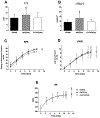Bilateral extracephalic transcranial direct current stimulation improves endurance performance in healthy individuals
- PMID: 29079458
- PMCID: PMC6298602
- DOI: 10.1016/j.brs.2017.09.017
Bilateral extracephalic transcranial direct current stimulation improves endurance performance in healthy individuals
Abstract
Background: Transcranial direct current stimulation (tDCS) has been used to enhance endurance performance but its precise mechanisms and effects remain unknown.
Objective: To investigate the effect of bilateral tDCS on neuromuscular function and performance during a cycling time to task failure (TTF) test.
Methods: Twelve participants in randomized order received a placebo tDCS (SHAM) or real tDCS with two cathodes (CATHODAL) or two anodes (ANODAL) over bilateral motor cortices and the opposite electrode pair over the ipsilateral shoulders. Each session lasted 10 min and current was set at 2 mA. Neuromuscular assessment was performed before and after tDCS and was followed by a cycling time to task failure (TTF) test. Heart rate (HR), ratings of perceived exertion (RPE), leg muscle pain (PAIN) and blood lactate accumulation (ΔB[La-]) in response to the cycling TTF test were measured.
Results: Corticospinal excitability increased in the ANODAL condition (P < 0.001) while none of the other neuromuscular parameters showed any change. Neuromuscular parameters did not change in the SHAM and CATHODAL conditions. TTF was significantly longer in the ANODAL (P = 0.003) compared to CATHODAL and SHAM conditions (12.61 ± 4.65 min; 10.61 ± 4.34 min; 10.21 ± 3.47 min respectively), with significantly lower RPE and higher ΔB[La-] (P < 0.001). No differences between conditions were found for HR (P = 0.803) and PAIN during the cycling TTF test (P = 0.305).
Conclusion: Our findings demonstrate that tDCS with the anode over both motor cortices using a bilateral extracephalic reference improves endurance performance.
Keywords: Endurance performance; Fatigue; Perception of effort; tDCS.
Copyright © 2017 The Authors. Published by Elsevier Inc. All rights reserved.
Conflict of interest statement
Conflict of interests
Dr. Santarnecchi serves as a consultant for EBNeuro Ltd, a manufacturer of TMS and tDCS devices. None of the devices used in the present experiments were provided by EBNeuro. Dr. Pascual-Leone serves on the scientific advisory boards for Nexstim, Neuronix, Starlab Neuroscience, Neuroelectrics, Axilum Robotics, Magstim Inc., and Neosync; and is listed as an inventor on several issued and pending patents on the real-time integration of transcranial magnetic stimulation with electroencephalography and magnetic resonance imaging.
Figures




References
-
- Santarnecchi E, Brem A-K, Levenbaum E, Thompson T, Kadosh RC, Pascual-Leone A. Enhancing cognition using transcranial electrical stimulation. Curr Opin Behav Sci 2015;4:171–8. doi:10.1016/j.cobeha.2015.06.003. - DOI
Publication types
MeSH terms
Substances
Grants and funding
LinkOut - more resources
Full Text Sources
Other Literature Sources

